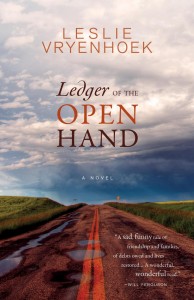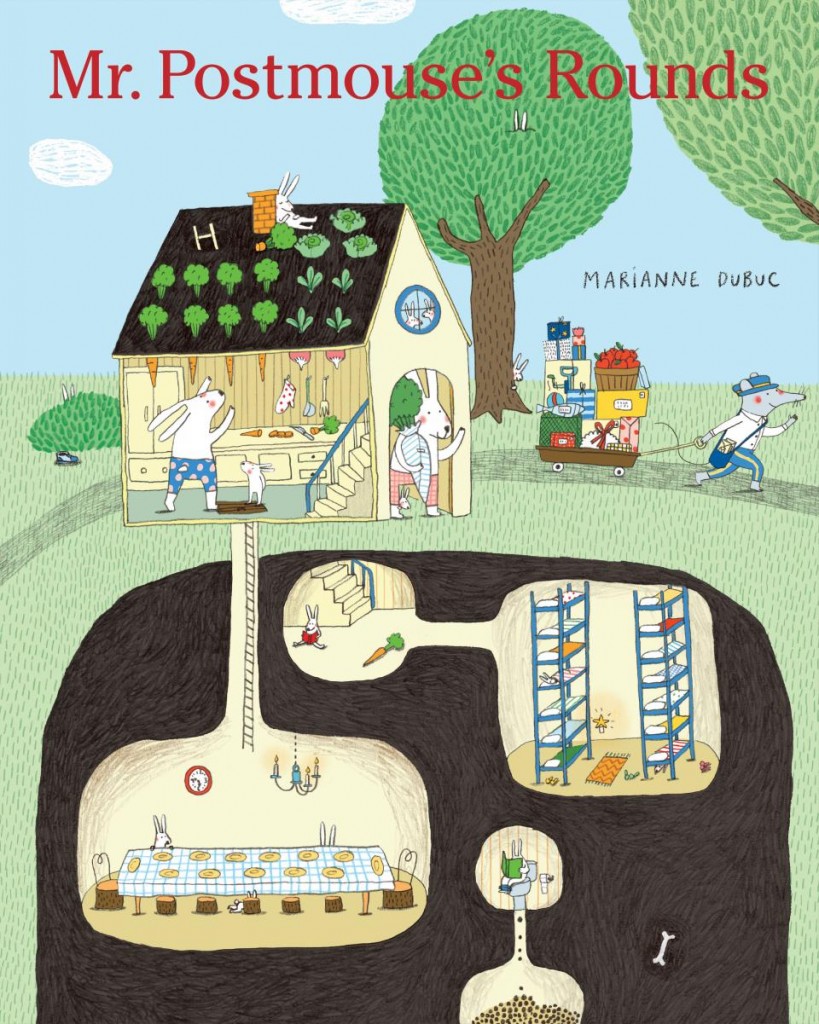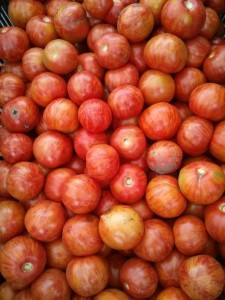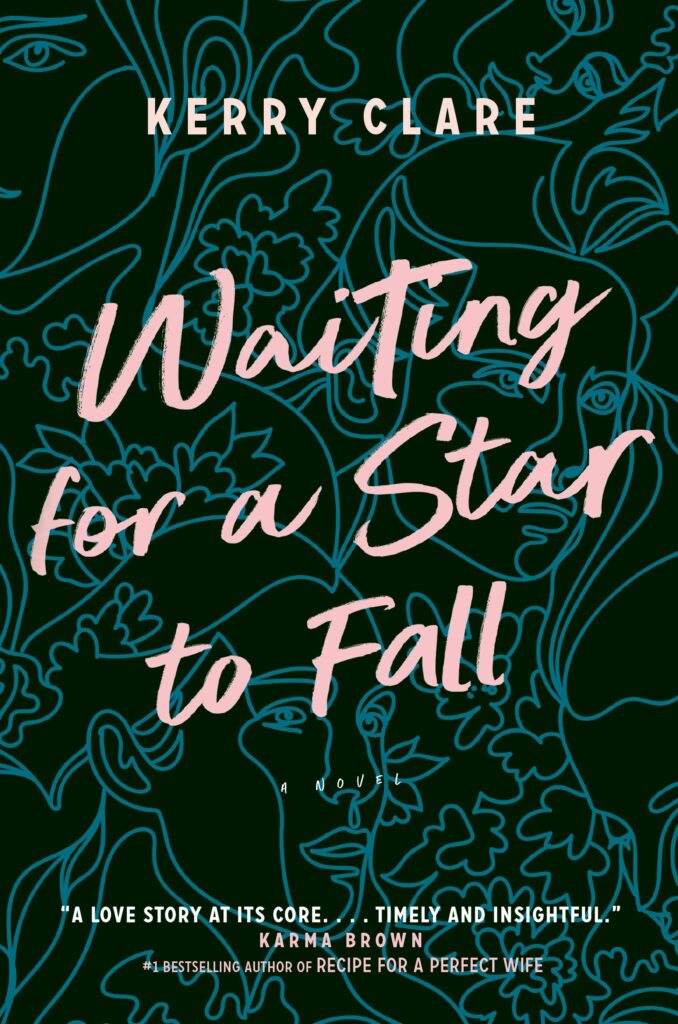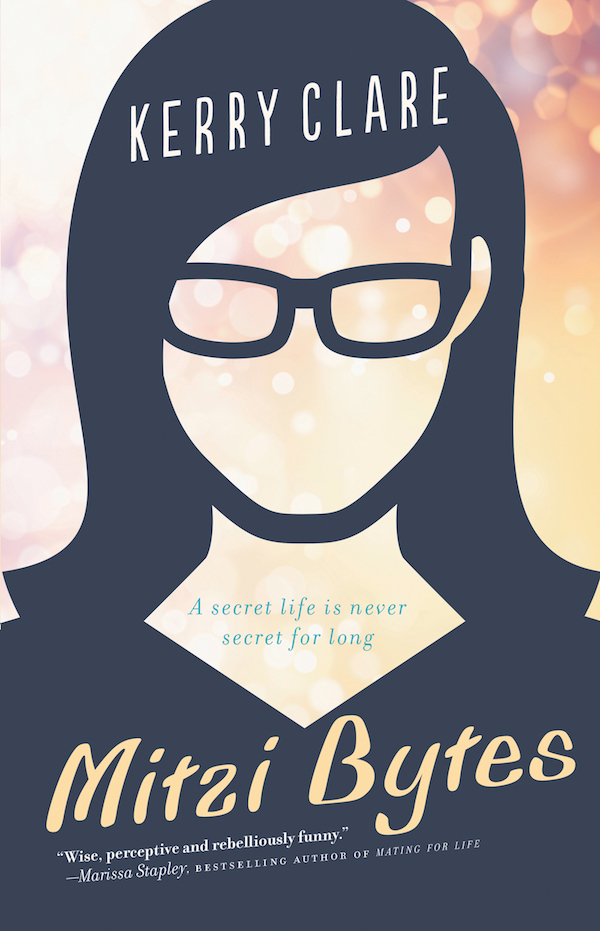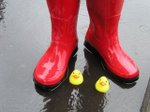October 6, 2015
Canadian books for high school readers
This summer, I got one of the coolest gigs I’ve ever had, the opportunity to write a list of suggested Canadian fiction titles with which high school English teachers can freshen up their syllabus. As I write in the piece, I was inspired by Natalee Caple’s “Why I Teach Brand New CanLit,” which was about university classes, but her points were just as relevant for high school teachers as well. And it was no challenge to come up with the 25 titles I ultimately included in the list—I do suspect that teachers are actually spoiled for choice in this context, should they choose to be.
My list appears at Education Forum, which is the magazine of the Ontario Secondary School Teacher’s Federation. You can read it here.
October 4, 2015
Ledger of the Open Hand, by Leslie Vrydenhoek
“Great civilizations aren’t remembered for their tax policies.” —Marsha Lederman, The Globe and Mail.
I thought of Ledger of the Open Hand, by Leslie Vryenhoek, when I read the quote above, from a story about the failure of politicians in our federal election to grapple with issues deeper than budgets and surpluses, to talk about anything except money. Because Vryenhoek’s novel is about a character just like these uninspired (and uninspiring) politicians, Meriel-Claire Elgin who sees the world in terms of debits and credits, who conflates value with values, and the novel is also about how limited is such a worldview.
Though it’s an easy trap to fall into, this obsession with fiscal responsibility and thinking of thrift as a moral virtue. Raised in a small prairie town by parents of modest means, Meriel-Claire is determined to prove herself responsible as she begins university in the city, working in the summers and part-time to supplement her parents financial support. Though she quickly sees her experience in contrast with that of her sophisticated roommate, Daneen, who takes her family’s wealth for granted. Their respective financial situations seem to demarcate their places in the world, Meriel-Claire decides, imagining herself as the hard-working ant while her grasshopper friend devotes herself to shallow and frivolous concerns. Unconsciously seeing the fable analogy to its end, Meriel-Claire envisions a day when there will be justice, when her hard-work and prudence will be rewarded and Daneen will meet her inevitable downfall.
But of course, life is not this simple, structured like a ledger sheet (which, cleverly, is suggested in the novel’s cover image), and neither is the novel. Interestingly, the story of the ant and the grasshopper has alternate versions in which it’s the grasshopper who is actually the virtuous one, and The Ledger of the Open Hand (like life itself) permits plenty of space for such ambiguity. The novel is broad in its scope, taking place over three decades, and showing the changes in the life of Meriel-Claire (and in her family’s) as she moves from her twenties to her forties. And because all of this is presented from Meriel-Claire’s point of view, everything is about money—she starts off as a bookkeeper and eventually becomes a debt counsellor; with colleagues and family, she gains a fierce (and justified) reputation as a tightwad. Though Meriel-Claire doesn’t see it quite that way herself, and Vryenhoek gives us real sympathy for her situation and how she got there, and the truth is that so much about being in the world is about money after all. It’s just simpler for people like Daneen who don’t have to worry about it. Of course it’s easy not to think about money all the time when you have no need to.
Written in short chapters that whisk the reader through the years, we follow Meriel-Claire through her first jobs, home-ownership, through failed investments and unexpected windfalls. We see her parents sell their business and begin to enjoy their retirement, and live a life that seems at odds with Meriel-Claire’s memories of her modest upbringing. Their distance from their daughter is augmented by tragedy in their lives, tragedy that none of them is really ever able to account for. And looking on through all of this is Daneen, who grows close to the family and eventually becomes a successful author whose stories seem a bit too familiar to Meriel-Claire, raising issues of just how much borrowing is permitted in matters of story as well as money, and also of how adept is anybody at seeing a reflection of her own self?
While all too present on the political stump, issues of finance are curiously absent from so much of literature, whose bills seems to get paid almost by magic (unless it’s a book about the farm and foreclosure). Vryenhoek manages to weave a deep and engaging novel out of money matters, though she makes it about more than that. While at times Meriel-Claire is a bit robotic in her approach to the world and Daneen can verge on caricature, Mariel-Claire’s parents are rich, complex and fascinating characters, and the connections between all these people over the decades yield surprising insights and remarkable depth, culminating in a really wonderful story. Vryenhoak’s prose is bright and accessible, the novel fast-paced and compelling, and there is a startling originality to all of it.
October 1, 2015
Mr. Postmouse’s Rounds by Marianne Dubuc
We are a little bit crazy for Marianne Dubuc in our house, which is interesting because she does something very different with every book she writes, but what all her books have in common are elements of whimsy, unabashed absurdity, rewards for those who are attentive to detail, and an all-engaging strangeness. And in Mr. Postmouse’s Rounds, she has written a book about the mail, and so naturally I am totally obsessed. As are my kids, because, well, look right there on the cover: there is a rabbit pooing. Sitting on the toilet reading, no less. And this glimpse into the rabbits’ hidden world is what’s so entrancing about this book, exploring these animal abodes that Dubuc has dreamed up: the bear’s house has honey on tap from a hive on the roof; the snake’s long skinny house is outfitted with heat lamps; the squirrel’s got a clothesline and sleeps in a hammock; the mole house has a kettle on the stove.
It’s the kind of book a kid can read with her finger, tracing along the Postmouse’s route and in and out of the houses he delivers to. While the illustration style is very different, we love it for the same reasons I loved Jill Barclay’s Brambly Hedge books when I was little, tiny worlds magnified, access into hidden corners, such incredible attention to detail. And yes, it’s funny. There’s the poo (and the flies’ house is actually a giant piece of much poo, much to everybody’s delight). And there are abandoned shoes, mitts and candy wrappers littering the animals’ neighbourhood, and just what’s going on in each of these dwellings? Each house containing a story of its own, so that you can read Mr. Postmouse’s Rounds over and over again and—which I know from experience—the young reader will continue to keep exploring its pages long after the reading is done.
October 1, 2015
The Possibility of Elephants
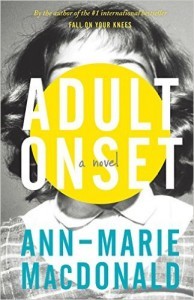 “I had a job at Pizza Hut in the last years of the old century, the location on Toronto’s Bloor Street just west of Avenue Road. I worked the take-out counter, serving ancient slices that were sweating under the heat-lamps, and one day I looked up from the till to see an elephant lumbering by, a bright emerald ribbon secured to its tail…”
“I had a job at Pizza Hut in the last years of the old century, the location on Toronto’s Bloor Street just west of Avenue Road. I worked the take-out counter, serving ancient slices that were sweating under the heat-lamps, and one day I looked up from the till to see an elephant lumbering by, a bright emerald ribbon secured to its tail…”
And so begins my essay on rereading Ann-Marie MacDonald’s Adult Onset, which is also about the mutability of memory, of literature, and of streetscapes, Bloor Street’s in particular. It’s about Balloon King, Starbucks, mistakes in fiction, parallel universes, and the Shafia family murders. It’s about Honest Eds and trauma, Daniel Libeskind’s “Crystal” and Jian Ghomeshi’s creepy voice. Plus, about having a two year old.
Anyway, I am really proud of it. As many of you already know, the word “essay” comes from the French verb “to try” and for me this piece was certainly an experiment. But I am very pleased with how it turned out, and grateful for Rohan Maitzen and her colleagues at Open Letters Monthly for their work on the piece, and for giving it such a wonderful home.
September 29, 2015
Sir John’s Table, by Lindy Mechefske
 I could never be a food blogger for all kinds of reasons, one of which is that all my pots and serving dishes are indelibly stained and my kitchen is old and grubby (and poorly lit). The other important reason is that I tend to interpret recipes as general guidelines instead of instructions, but in the case of the new book, Sir John’s Table, by Lindy Mechefske, this turned out to be an advantage. It meant I was unafraid to take on the recipe for Sir John A’s Pudding from a cookbook from the 1880s, a recipe named in honour of the first Prime Minister of Canada, whose instructions included “size of an egg” for butter portioning, no word on what vessel to cook it in, and vague baking instructions as follows: “Bake in oven for a few minutes.”
I could never be a food blogger for all kinds of reasons, one of which is that all my pots and serving dishes are indelibly stained and my kitchen is old and grubby (and poorly lit). The other important reason is that I tend to interpret recipes as general guidelines instead of instructions, but in the case of the new book, Sir John’s Table, by Lindy Mechefske, this turned out to be an advantage. It meant I was unafraid to take on the recipe for Sir John A’s Pudding from a cookbook from the 1880s, a recipe named in honour of the first Prime Minister of Canada, whose instructions included “size of an egg” for butter portioning, no word on what vessel to cook it in, and vague baking instructions as follows: “Bake in oven for a few minutes.”
We really weren’t sure. “This is an experiment,” I kept telling my family, and then asking them, “Isn’t living with me a glorious adventure?” No one answered. They were all a bit irritated that our main course had been roast cauliflower. “I bet none of your friends are having pudding tonight in honour of Canada’s first Prime Minister,” I told Harriet. She looked at me funny: “Mom, do we have any ice cream?”
 Sir John A’s Pudding is from Dora’s Cook Book, by Dora E. Fairfield, published in 1888—one known copy is still publicly available. It is a bread pudding, the bottom made with bread crumbs, egg yolks and lots of milk. Spread on top are stiff egg whites and sugar. I baked the whole thing in the oven for much longer than a few minutes (though I can’t remember how long now—I am as bad as Dora). When it came out of the oven, the topping was nicely browned but the pudding still seemed a little gloopy (“But gloopy means delicious, right?” I asked. Nobody cheered.) However once it had been resting for a little while the pudding was set, and now it was finally time to dish it up and assess the damage.
Sir John A’s Pudding is from Dora’s Cook Book, by Dora E. Fairfield, published in 1888—one known copy is still publicly available. It is a bread pudding, the bottom made with bread crumbs, egg yolks and lots of milk. Spread on top are stiff egg whites and sugar. I baked the whole thing in the oven for much longer than a few minutes (though I can’t remember how long now—I am as bad as Dora). When it came out of the oven, the topping was nicely browned but the pudding still seemed a little gloopy (“But gloopy means delicious, right?” I asked. Nobody cheered.) However once it had been resting for a little while the pudding was set, and now it was finally time to dish it up and assess the damage.
Guess what: it was totally divine. And everyone conceded that living with me was an adventure after all, a most delicious one. I did my I’m always right dance. I always mostly am.
Though not, admittedly, with my immediate assessment of Mechefske’s book. Sir John’s Table: A Culinary Life and Times of Canada’s First Prime Minister as a concept did not seem at first compelling to me, but then I opened it up and started reading. And what I found was an engaging, light and fun and informative text. So engaging, yes, that it led me to attempt archaic heritage recipes, plus the book is also a really interesting biography of Canada’s first Prime Minister.
 Since we’re going all Full Disclosure in this post, I will reveal to you that I’ve not watched any political debates during this current federal election. As these debates fail the Bechtel Test on every discernible level, are intellectually stupefying AND we don’t have TV, I’ve felt more comfortable getting my political information from newspapers instead. There is something about the absence of women’s voices and the general feeling that anything concerning women’s experiences is mere frippery that renders most politics (and political biographies) null and void to me. It’s grown-ups acting out playground games, and taking themselves far too seriously. It’s just inherently uninteresting.
Since we’re going all Full Disclosure in this post, I will reveal to you that I’ve not watched any political debates during this current federal election. As these debates fail the Bechtel Test on every discernible level, are intellectually stupefying AND we don’t have TV, I’ve felt more comfortable getting my political information from newspapers instead. There is something about the absence of women’s voices and the general feeling that anything concerning women’s experiences is mere frippery that renders most politics (and political biographies) null and void to me. It’s grown-ups acting out playground games, and taking themselves far too seriously. It’s just inherently uninteresting.
Which is not to say that political biographies must necessarily contain a recipe for bread pudding, or that the domestic is anymore inherently a female purlieu, but it certainly was in the 19th century. Which means that “culinary life and times” of Sir John A. Macdonald is going to give special attention to the women in his life and the personal and political roles they played: his mother, his wives, his lifelong friend who was also a pub owner. We learn about the food (bannock!) his mother brought to feed her family on the long voyage from Scotland to Canada. Also about Macdonald’s favourite childhood desserts, how traditional British foods were adapted to North America, wedding cakes from the 1860s, mourning rituals (after the death of his first wife), how the picnics at which he made his famous stump speeches would have been catered (by Mrs. Beeton, at least), and just how a roast duck dinner managed to save the Dominion after all.
For a light book, Mechefske manages to be rigorous about colonial atrocities, juxtaposing a lavish Toronto dinner with Metis and First Nations people starving on the plains at the same time. Her story of the triumph of Sir John A’s railroad also includes a legacy of racism and exploitation of the Chinese workers who built it. She manages to balance her portrayal of the generous and charismatic Macdonald with the dark side of his legacy—also his own propensity for problems with drink: “He joined the Temperance Society again,” is a sentence that pops up more than once.
My one criticism is that the recipes have not been adapted for modern cooks, and so are more a curiosity than something the reader can use. Although there is value too in these heritage recipes reprinted as they were, for what they tell us about how 19th century cooks did their work, how ingredients, measurements and cooking methods were different, and also the peculiar stylistic quirks of their writers. And my own experience certainly shows (who knew?!) that the intrepid 21st century cook can have success with these recipes all the same.
September 27, 2015
Fishbowl, by Bradley Somer
 It’s true what you might have heard about Bradley Somer’s Fishbowl being a novel that actually chronicles a goldfish’s plummet from the twenty-seventh floor balcony of a high rise apartment building. (I heard my first raves about this book from the Parnassus Books blog.) And yes, the goldfish parts of the novel are actually from the fish’s point of view: at one point, one eye is skyward, and the other is focussed on the ground—what must the world look like like that?; his brain is too limited for a train of thought—it’s more like a handcar. Yes, the fish’s name is name is Ian. And it’s also true what you might have heard about Fishbowl if the thing you’ve heard is that it’s great.
It’s true what you might have heard about Bradley Somer’s Fishbowl being a novel that actually chronicles a goldfish’s plummet from the twenty-seventh floor balcony of a high rise apartment building. (I heard my first raves about this book from the Parnassus Books blog.) And yes, the goldfish parts of the novel are actually from the fish’s point of view: at one point, one eye is skyward, and the other is focussed on the ground—what must the world look like like that?; his brain is too limited for a train of thought—it’s more like a handcar. Yes, the fish’s name is name is Ian. And it’s also true what you might have heard about Fishbowl if the thing you’ve heard is that it’s great.
The structure of fishbowl is similar to the apartment building that is its setting, each unit home to its own story, stories stacked on top of stories. Common spaces are spare, unremarkable. Nobody lingers there. For each character it’s easy to imagine that he or she is alone in the world, to disregard the sound of footsteps overhead. But one day when the elevator breaks down, the illusion is shattered. Suddenly lives are intersecting in curious, irrevocable ways. A baby is about to be born. An old man has died. A cheating lover is about to meet his comeuppance. A lonely burly crossdressing construction worker is about to feel more beautiful than he’s ever felt before. And Ian the goldfish is about to be launched upon the ride of his life.
Eschewing a linear narrative for something more like a fish’s grasp of eternity, the novel takes place over a half hour or so, moving back and forth within that span of time (and sometime telescoping omnisciently into a distant future) to examine the period from a variety of points of view. For those ascending the building’s staircase—the elevator is broken, remember—time moves in slow motion, ploddingly, exhaustingly. For the lying cheat upstairs who is hurriedly ridding his bachelor suite of all signs of debauchery, time moves much too fast, not enough of it to allow him to clear away the evidence. For the woman whose baby is coming, everything is happening much too quickly, but also taking forever. And when she finally manages to reach her boyfriend at the pub, he tells her that he’ll be there—after one more round.
Fishbowl is a novel about relativity and relationships, and infinite interconnectedness of things. It’s also funny, absorbing, poignant, rich with twists and surprises, smartly plotted, deep and intelligent. And heartwarming—if you’re into that kind of thing. Underlining that although a person might be lonely, she is never really alone.
September 25, 2015
A Veritable Marathon
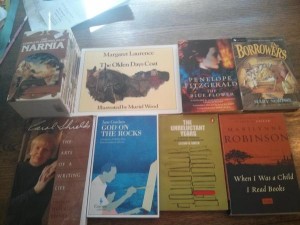 This morning I had the pleasure of dropping my children off at their respective schools, and then heading over to Victoria College to pre-drink for the book sale which started at 10am. By which I mean that I ordered a chocolate croissant and a cup of tea at Ned’s Cafe, and indulged in all of it—the food, the time, the solitude, the book sale anticipation. Thinking also about the extraordinary kindness with which people have responded to my previous blog post, and how it has caused all kinds of people special to me but far flung to get in touch after ages, and the whole thing has all been wonderfully buoying. I wasn’t expecting that. I just needed to get the words out, all 2000 of them, which took and hour and a half the other night, but it was time well spent, I can now say. As was this morning, the pleasure of my own company. I have adjusted extraordinarily well to having my mornings free (of the children, I mean; my mornings are generally full of work—I worked extra hard this week so that today I wouldn’t have to). The whole arrangement is so good, I feel like it should be illegal.
This morning I had the pleasure of dropping my children off at their respective schools, and then heading over to Victoria College to pre-drink for the book sale which started at 10am. By which I mean that I ordered a chocolate croissant and a cup of tea at Ned’s Cafe, and indulged in all of it—the food, the time, the solitude, the book sale anticipation. Thinking also about the extraordinary kindness with which people have responded to my previous blog post, and how it has caused all kinds of people special to me but far flung to get in touch after ages, and the whole thing has all been wonderfully buoying. I wasn’t expecting that. I just needed to get the words out, all 2000 of them, which took and hour and a half the other night, but it was time well spent, I can now say. As was this morning, the pleasure of my own company. I have adjusted extraordinarily well to having my mornings free (of the children, I mean; my mornings are generally full of work—I worked extra hard this week so that today I wouldn’t have to). The whole arrangement is so good, I feel like it should be illegal.
And the book sale? (BTW, this year they have a blog!) It was fantastic, and this is the first time I’ve not had to browse while toting a screaming baby. (Last year, whenever I turned a corner, someone would look up and say, “Oh, that was your baby crying.”) I’d intended to buy very few books, but it turns out that’s far simpler to accomplish when one is doing the toting a screaming baby thing. This year, alone, I managed to put down far more books that I picked up, but still came away with a sizeable pile, although nothing on years past. Complete Chronicles of Narnia—we’re halfway through The Lion, the Witch and the Wardrobe now, and we’re loving it. (Stuart and I, growing up on different continents, were both traumatized by the cartoon film version of this book as children, so have never really read the books.) So we look forward to reading the other books in the series. And also The Borrowers, and Margaret Laurence’s The Olden Days Coat to add to our Christmas Book library.
I picked up Carol Shields: The Art of a Writing Life, which I read about ten years ago but would like to read again. Marilynne Robinson’s When I Was a Child I Read Books, because Kate Sutherland handed it to me, and I generally follow her advice on most things. The Unreluctant Years: A Critical Approach to Children’s Literature, by Lillian H. Smith, famous Toronto children’s librarian who now has a library in her name. Published in the 1950s, I’m interested to see how this reads now—particularly now since I am an official children’s literature expert myself.
And finally, the novels. I walked around in the fiction section upstairs and was at one point holding a stack of ten books, which is lunacy because I have so many books to read already, I do not need to be gathering more. So I whittled my pile down to The Blue Flower, by Penelope Fitzgerald, and God On the Rocks, by Jane Gardam, both is excellent condition, and I feel very good about my choices.
Even with the tea and croissant, however, I find myself exhausted by the whole experience. One who has never lived it could not imagine how tiring it is to browse for books for two hours, pressure on the back, the shoulders, all that standing. Not to mention fighting for space with other browsers, elbow weaponry. Carrying the books around in the meantime. It’s a veritable marathon.
Thankfully I am an athlete in my prime.
September 24, 2015
Solid Gold
This week for Picture Book Friday, I bring you the October issue of Quill and Quire, which is on newsstands now. As part of their special Kidlit Spotlight, I took part in a panel discussion focussed around the question, “Are we living in a golden age of Canadian picture books?” It was a very neat, informative and wide-ranging discussion with a bunch of kidlit experts (of which I am now—it’s official). As someone with strong opinions about most books I read, good and bad, it was interesting to hear from others with different points of view. (This is the reason I’m never going to start the blog I was born to write, called “Picture Books I Really Hate”, because these things are so subjective.) It was also really interesting to learn from people whose roots in Canadian children’s books go back to the 1970s (which is basically when Canadian children’s literature began) and find out what is different and what has stayed the same. And is this a golden age? I really do think so. I was pleased that my quotation from Ursula Nordstrom closed our discussion, about books that are written from the outside in, versus books written from the inside out (i.e. the best kind). And there is such a greater level of sophistication in Canadian books at the moment, even by the same writers who were working 30 years ago. Kathy Stinson’s Red is Best is a classic, timeless and fantastic children’s book, but her recent award-winning The Man With the Violin is on a whole other level, which is where so many picture books are appearing these days. It’s a real pleasure to be a part of this literary moment.
Also in the issue are great children’s book reviews, and plenty of other good stuff. Make sure you pick up a copy!
September 23, 2015
Why I keep shouting my abortion
I can’t remember when I started talking about my abortion. When it happened, my girlfriends knew, of course, and obviously so did my boyfriend, but in general, I kept it quiet. I don’t remember why. I think I was profoundly embarrassed and ashamed at having become pregnant in the first place. It was also a terrible time, a really awkward situation in which I had to come home early from my post-university European tour to have the procedure. (I wrote about this all here: I always knew I would. It really was the most interesting thing that has ever happened to me.) I remember other friends inquiring as to why I was back in Toronto, and I didn’t say anything about it. I think I was just waiting for all that time to be over and done with; if I didn’t tell the story, I could imagine that it had never happened.
My husband knew very early in our relationship. I was still quite a bit bonkers about the whole thing when we met, which is not to say that having an abortion was a bad decision, but just that the whole experience (accidental pregnancy, having my life fall apart, etc.) was awful and it took me a very long time to get over it—though he helped by being wonderful and good. And beyond that, in years to come, my abortion was the kind of thing that came up in conversations with friends once we’d had too many drinks. Because everybody’s got a story. I was never ever alone in any of this, but it wasn’t the kind of thing I talked about in daylight.
As time went on, I started to become concerned. Abortion, to which I owe my life, I think, started to become more and more politicized. Or maybe I just grew up and started paying attention. And it bothered me that the only people who were talking publicly about abortion were men who were trying to sign bills to deny women access to it. It was becoming clear that I’d have to become more political as well.
My first public act as a pro-choice person was attending the pro-choice Jane’s Walk in 2011, learning about the abortion landmarks in my neighbourhood, including the clinic around the corner from my house that was fire-bombed in 1992. I had no idea. And as this event took place on Mother’s Day, it only underlined how connected my experiences of abortion and motherhood were, however incongruously (if you are the person who has trouble grasping two realities at once—in recent days, I have learned this is a lot of people). This experience would be the basis of my essay, “Doubleness Clarifies”, which was published in The M Word (and later reprinted in The Huffington Post).
Practicing for the essay’s entrance into the world, I published a blog post two and a half years ago when Dr. Henry Morgentaler died in which I noted that the reason this man was so important to me was not only had he fought valiantly for Canadian women to have access to abortion, but he’d actually performed mine. And there: I’d said it. I was a woman who’d had an abortion. It turned out to not be so difficult after all.
It was particularly not difficult because the support I received in response and in response too to The M Word essay was overwhelming. And I mean my mom and dad buying cases of my book and standing proud in the audience at the launch as I read my essay, to my mother-in-law quietly “liking” my Facebook posts, and my husband never ever getting tired of my increasing comfort with the subject. The people who matter, of course. But also the women who came up to me after readings who whispered, “that was me,” the journalist who wrote about my story and said the same thing, the reviewer whose understanding of abortion had been shaped by her own miscarriages and who with my essay saw it from a different point of view, and the amazing Plum Johnson who I read with at an event filled with 200 suburban matrons and when I confessed that I was nervous about that particular crowd said, “What? You think nobody here has ever had an abortion?”
Truth: I’d rather not be talking about my abortion. Not now at least. And not because it’s painful, or because I’m ashamed, but because it’s history. And because I’m wary of becoming someone who talks about her abortion all the time. As in, “We know Kerry. You’ve told us that story.” Abortion is not my only trick. I am interested in many other things, such as literature, bunting, the upcoming Federal Election, and Devon Closewool Sheep. I’m also wary because I know it seems insensitive to talk about my abortion all the time when my friends and acquaintances have their own stories: infertility, miscarriages, sick children, dead children. But the costs of staying quiet to stay polite are really starting to seem too high. And I really do believe that all these stories are part of the same story, a larger story about women’s lives. So I keep returning to abortion again and again.
In the summer I was walking down Bloor Street pushing Iris in a stroller, having just dropped Harriet off at day camp. We were hurrying home for lunch and nap, but I had to stop at the corner of Bloor and St. George where two very young people were holding pictures of lentil-sized fetuses magnified so they were bigger than I was. (What, when blown up at that level, would not be disturbing to look at?) Now I have walked past pro-life activists many times in my life because I lacked the courage to do anything but, because I do not like confrontation, and yes, because I always have better things to do than talk to people who standing on the sidewalk holding signs.
But it was different this time. Because this time, I’d learned to talk about my abortion in public. And as a person with that knowledge, I had an obligation, I thought, to speak up again. To stop there and talk to that impossibly young girl who’s trying to pass me a pamphlet with a number to call for support should I happen to regret my abortion (“We’re not judging you,” she tells me) and tell her, no no no. To point to my daughter sitting there waiting to be given her lunch, and say, “This is my baby. This baby would not exist were it not for my abortion. This life, this amazing life, my life, would not exist were it not for my abortion.” To say to her, “I have two children and I’ve had an abortion. There I things I know that you don’t know. Do not dare to stand here on the street and purport to educate me. Allow me to educate you.”
“There was nothing I wouldn’t have done to end my unwanted pregnancy, that my desperation had been just the same as that of all those women who’d had unsterile elm bark slipped through their cervixes to induce abortion, but that I hadn’t had to kill myself in order to relieve it.”
For the past few days, the hashtag #ShoutYourAbortion has been trending on Facebook, started by feminist activists Lindy West and Amelia Bonow in the US. (Read West’s piece in The Guardian: “I set up #ShoutYourAbortion because I am not sorry, and I will not whisper.”) This was my kind of bandwagon, so naturally I jumped on, sharing my essay from The M Word. And while the response to the hashtag was just the kind of thing I like to see—this conversation being owned by the women who’ve lived it, who for once are not trying to stay quiet for fear of offending sensibilities. It feels good to talk about your abortion out loud, this thing that made you and to not have to keep the story inside. It’s nice to see the thing I know is true from all those late night conversations over too many beers really is true after all: women have abortions, we get on with our lives, this is an ordinary, quotidian thing, and while the decision can be “harrowing” or “difficult,” sometimes it is just a thing. Sometimes an abortion can deliver the greatest kind of relief.
Of course, the hashtag got hijacked, levels of hatred I’ve never seen before. I don’t engage in online arguments ever, and certainly not with people whose twitter header photos feature their gun collections. I started to realize there was a direct correlation between people with American flags in their header photos, and the need to tell me that I was evil. I suggested to one woman that maybe Jesus (who, according to her twitter bio, was the answer to every question) might have shown some more compassion, and she informed me that unless one had repented, one was against Jesus, with Satan. (I had no idea. They didn’t teach that at my Sunday school.) Murderer. Murderer. Murderer, they said. Along with slut. I saw “trollop” once. I have never been witness to such abject hatred as these people (who claim so much to love babies) have for women who’ve had abortions.
I tweeted, “So much hatred by #ShoutYourAbortion trolls. If you can feel for a lentil-sized fetus, surely you can empathize with actual human woman too?” It’s been retweeted nearly 300 times, which counts as viral by Kerry Clare standards, and favourited 736 times, but this means that I’ve been exposed to even more lunacy, people who want to debate me on this. To what end, I don’t know: it’s not like I’m going to go back in time and not have an abortion. And they keep wanting to tell me things I already know, like that my decision was a selfish one, and there is an odd contradiction in talking about abortion when you’re actually a mother (although this isn’t a contradiction at all, but these people have small minds), and that not all aborted fetuses are the size of lentils (although everyone I know who has ever had an abortion later than 8 weeks or so did so with heartbreak in order to avoid the trauma of carrying a nonviable pregnancy to term, so fuck you asshole), and that unborn babies don’t get to make a choice (welp?), and of course, there is always adoption. Of course there is.
Um, there was also the guy who told me that I was a Nazi who had morals on par with ISIS. Later he tweeted about how he didn’t abort his hydrocephalic baby. The guy was a moron, but I got him then—his feelings spring from a genuine (albeit limited) place that I can understand. I even understand the woman who’s determined to stamp out abortion because of how it hurts women—apparently she spends her days holding other women who are traumatized by theirs. (Perhaps less shame and stigma might ease this kind of pain. Also, where is this woman hanging out? Sounds terrible. She needs new friends.) And yes, many of these people are just people who hate everybody, women in particular. “You shouldn’t be able to have everything you want!!” somebody tweeted at me. “But I can,” I wanted to crow. “I do!!!!”
My husband has finally told me to stop talking. On twitter at least. “These people are crazy,” he said. “These are people who would literally kill you and think that’s okay.” He also points out that I have better things to do than argue online with sub-literate people with eggs for avatars, and he’s right on both points. It’s also really, really exhausting.
So yes, no more twitter exchanges, but I’m not done with the hashtag yet. I’m not done with talking about my abortion either. And I’m guess I’m just laying the whole thing out here so that perhaps you’ll understand why.
September 22, 2015
The Day the Crayons Came Home
True confession: I don’t love The Day the Crayons Came Home, by Drew Daywelt and Oliver Jeffers, quite as much as I loved its predecessor, The Day the Crayons Quit. The premise is the same but it’s just not as fresh. However my children are quite nuts for the book, and during the first few days after we bought it, Harriet insisted on taking it to bed every night. So when I heard about Small Print TO’s Crayon Creator’s Club event this weekend, I knew we had to be there.
And so on Saturday morning, we headed down to The Lillian Smith Library (which is the most special twenty-year-old building in the universe) and my children posed with the enormous crayons adorning the entrance. We were able to buy a copy of Harold and the Purple Crayon (can you believe we didn’t have it yet) and listened to the story, before the children were let loose to do some purple crayon-ing of their own. (We also learned that Harold actually grew up to be a graffiti artist, ala Bansky.)
After that, we reassembled for The Day the Crayons Came Home, which is about Duncan’s crayons that have been lost, abandoned or broken over the years—left behind on holidays, stuck between couch cushions, puked up by the dog. In the end [SPOILER ALERT] Duncan welcomes his colouring implements home by building them a crayon fort that meets all their special needs now that they’re in altered states. And then each of the children got to work constructing a crayon fort of her or his own.
Next up: the door prize. Guess who was quite thrilled to win a crayon that is taller than she is? (And she doesn’t mind in the slightest that it doesn’t actually colour. If it were made of wax, it would have been even to carry home than it already was.)
All in all, it was a most rewarding morning at one of our favourite places. We posed out by one of the gryphons for posterity.
And speaking of Lillian H. Smith and crayons, I’m quite excited about the All the Libraries colouring book by Daniel Rotsztain, coming next month from Dundurn Press, featuring drawings of every single Toronto Public Library Branch for your colouring pleasure. You can learn more about the project and see some drawings here.

